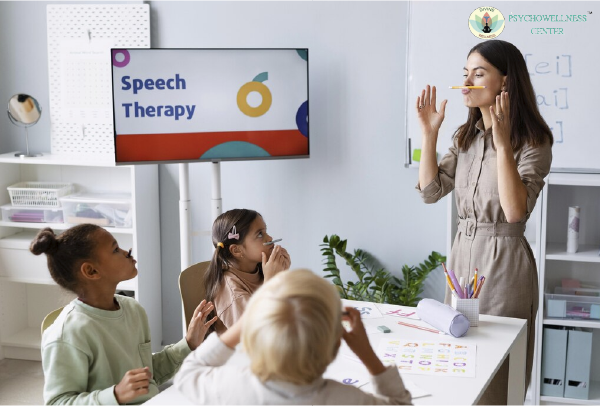The ability to communicate is essential because it enables us to convey our needs, wants, and thoughts. For individuals with communication disorders, this can be a daily challenge. Communication difficulties can affect both children and adults and may range from trouble speaking clearly to issues with understanding or expressing language. Fortunately, speech therapy techniques can significantly enhance a person’s communication abilities.
This blog explores several speech therapy techniques commonly used to treat communication disorders, focusing on approaches that assist individuals, especially those with anxiety, Specific Learning Disabilities (SLD), autism, and ADHD, in improving speech, language, and overall communication skills.
What is Speech Therapy?
Speech therapy is a therapeutic approach used by trained speech-language pathologists (SLPs) to help individuals overcome or manage communication disorders. The therapy aims to improve or restore speech, language, and cognitive-communication skills, and is often used in coordination with other interventions like occupational therapy, play therapy, and Applied Behavior Analysis (ABA therapy), especially in children diagnosed with autism or ADHD.
Treatment plans are tailored to each individual’s needs and may include exercises to strengthen speech muscles, enhance articulation, or develop better communication strategies.
Common Communication Disorders
Individuals may face various communication challenges, including:
- Articulation Disorders: Difficulty pronouncing words correctly.
- Language Disorders: Trouble understanding or using language.
- Voice Disorders: Issues about voice loudness, pitch, or quality.
- Fluency Disorders: Problems that interfere with speech, such as stuttering.
- Cognitive-Communication Disorders: Communication issues resulting from neurological or cognitive impairments.
These disorders may coexist with anxiety, SLD, ADHD, Phobia, PTSD, or autism, requiring a holistic treatment approach involving top psychologists and multidisciplinary care.
Key Speech Therapy Techniques
- Articulation Therapy
Designed for those struggling with pronunciation, articulation therapy helps correct sound errors by teaching the proper placement of the tongue, lips, and jaw.
Methods:
- Sound Blending: Helps in merging sounds into words.
- Sound Discrimination: Teaches the distinction between right and wrong sounds.
- Visual Aids: Mirrors or diagrams help in understanding correct mouth positioning.
Example: A child with SLD or autism might practice the “r” sound by repeating words like “rain” and “rabbit,” guided by visual feedback.
2. Language Therapy
Language therapy supports individuals with challenges in vocabulary, grammar, comprehension, or expression, common in children with ADHD, autism, or SLD.
Methods:
- Receptive Language Exercises: Understanding instructions or identifying objects.
- Expressive Language Activities: Using new vocabulary in conversation or storytelling.
- Interactive Play Therapy: Using toys, storybooks, or games to enhance language skills.
Example: A therapist may use a picture book and ask the child to describe what they see, fostering expressive language development in children with autism or ADHD.
3. Fluency Therapy (Stuttering Treatment)
Fluency therapy addresses stuttering, a barrier that often causes social anxiety and impacts confidence.
Methods:
- Slow Speech: Encouraging a slower speech rate for better fluency.
- Pausing Techniques: Teaching where to pause for better rhythm.
- Breathing Exercises: Supporting breath control and reducing tension.
Example: A person with anxiety-induced stuttering might be guided to speak in slow, deep-breathing-supported sentences during therapy.
4. Voice Therapy
People with voice disorders—sometimes stemming from emotional issues or poor vocal habits—can benefit from targeted therapy to improve voice quality.
Methods:
- Breathing Techniques: Deep breathing to support voice production.
- Pitch Control: Exercises to avoid straining the voice.
- Resonance Training: Enhances vocal tone and clarity.
Example: Someone with hoarseness may practice soft humming to restore vocal resonance.
5. Cognitive-Communication Therapy
This therapy benefits individuals recovering from stroke, brain injury, or dealing with dementia, and supports those with co-occurring conditions like ADHD or anxiety.
Methods:
- Memory Tasks: Enhancing recall and attention.
- Problem-Solving Exercises: Improving conversation and reasoning skills.
- Role-Play Conversations: Practicing real-life interactions.
Example: An elderly stroke survivor might work on naming objects, helping both memory and verbal fluency.
The Role of Family and Caregivers
Active involvement from family members and caregivers enhances therapy outcomes. Home-based reinforcement of therapeutic techniques, particularly for children with autism, ADHD, or SLD, is vital. Success and consistency are guaranteed by the advice of top psychologists and speech-language pathologists.
Conclusion
Speech therapy offers transformative solutions for those struggling with communication disorders. Whether the issue is articulation, fluency, language, cognitive skills, or related to broader conditions like autism, ADHD, SLD, or anxiety, a personalized, multidisciplinary approach can make a lasting difference.
Support from top psychologists, coordination with ABA therapy, occupational therapy, and play therapy, and early intervention are key to improving communication and building confidence in both children and adults.
Contributed by Ms. Sakshi Dhankhar, Counselling Psychologist
References:
- American Speech-Language-Hearing Association (ASHA). (n.d.). Speech sound disorders.
- National Institute on Deafness and Other Communication Disorders (NIDCD). (2021). Speech and language disorders.
- American Speech-Language-Hearing Association (ASHA). (n.d.). Fluency disorders (stuttering).

